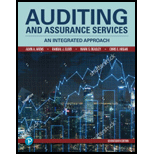
EBK AUDITING+ASSURANCE SERVICES
17th Edition
ISBN: 9780135171219
Author: ARENS
Publisher: PEARSON CO
expand_more
expand_more
format_list_bulleted
Question
Chapter 12, Problem 7RQ
To determine
Identify the extent up to which an auditor can rely on the audit of prior years.
Expert Solution & Answer
Want to see the full answer?
Check out a sample textbook solution
Students have asked these similar questions
Please provide the solution to this general accounting question using proper accounting principles.
What is the total manufacturing cost for the period?
Please provide the answer to this financial accounting question using the right approach.
Chapter 12 Solutions
EBK AUDITING+ASSURANCE SERVICES
Ch. 12 - Prob. 1RQCh. 12 - Prob. 2RQCh. 12 - Prob. 3RQCh. 12 - Describe how the nature of evidence used to...Ch. 12 - Prob. 5RQCh. 12 - Prob. 6RQCh. 12 - Prob. 7RQCh. 12 - Prob. 8RQCh. 12 - Prob. 9RQCh. 12 - Prob. 10RQ
Ch. 12 - Prob. 11RQCh. 12 - Prob. 12RQCh. 12 - Prob. 13RQCh. 12 - Prob. 14RQCh. 12 - Prob. 15RQCh. 12 - Prob. 16.1MCQCh. 12 - Prob. 16.2MCQCh. 12 - Prob. 16.3MCQCh. 12 - Prob. 17.1MCQCh. 12 - Prob. 17.2MCQCh. 12 - Prob. 17.3MCQCh. 12 - Prob. 18.1MCQCh. 12 - Prob. 18.2MCQCh. 12 - Prob. 18.3MCQCh. 12 - Prob. 19.1MCQCh. 12 - Prob. 19.2MCQCh. 12 - Prob. 19.3MCQCh. 12 - Prob. 20DQPCh. 12 - Prob. 21DQPCh. 12 - Prob. 22DQPCh. 12 - Prob. 23DQPCh. 12 - Prob. 24DQPCh. 12 - Prob. 25DQPCh. 12 - Prob. 26DQPCh. 12 - Prob. 27DQPCh. 12 - A CPAs client, Boos Baumkirchner, Inc., is a...Ch. 12 - Prob. 29DQPCh. 12 - Prob. 30DQPCh. 12 - Based on a cost-benefit analysis, management at...Ch. 12 - Prob. 32DQPCh. 12 - Prob. 33DQPCh. 12 - Prob. 34DQP
Knowledge Booster
Similar questions
- Solve this financial accounting problemarrow_forwardKindly help me with this General accounting questions not use chart gpt please fast given solutionarrow_forwardElizabeth Corp. sold 3,800 units of its product at a price of $92.25 per unit. The total variable cost per unit is $63, consisting of $41.50 in variable production cost and $21.50 in variable selling and administrative cost. Compute the manufacturing margin for the company under variable costing. a. $192,850 b. $94,960 c. $196,140 d. $333,900 e. ($139,180)arrow_forward
- Bentley Industries applies manufacturing overhead on the basis of direct labor hours. At the beginning of the most recent year, the company based its predetermined overhead rate on a total estimated overhead of $127,500 and 5,100 estimated direct labor hours. Actual manufacturing overhead for the year amounted to $131,200 and actual direct labor hours were 4,800. The applied manufacturing overhead for the year was closest to __.arrow_forwardCompute the company's predetermined overhead ratearrow_forwardThe Hidalgo Company uses the weighted-average method in its process costing system. The company's ending work in process inventory consists of 18,500 units. The ending work in process inventory is 100% complete with respect to materials and 60% complete with respect to labor and overhead. If the costs per equivalent unit for the period are $3.75 for materials and $5.20 for labor and overhead, what would be the balance of the ending work in process inventory account? (Do not round cost per equivalent unit).arrow_forward
arrow_back_ios
SEE MORE QUESTIONS
arrow_forward_ios
Recommended textbooks for you
 Auditing: A Risk Based-Approach (MindTap Course L...AccountingISBN:9781337619455Author:Karla M Johnstone, Audrey A. Gramling, Larry E. RittenbergPublisher:Cengage Learning
Auditing: A Risk Based-Approach (MindTap Course L...AccountingISBN:9781337619455Author:Karla M Johnstone, Audrey A. Gramling, Larry E. RittenbergPublisher:Cengage Learning Auditing: A Risk Based-Approach to Conducting a Q...AccountingISBN:9781305080577Author:Karla M Johnstone, Audrey A. Gramling, Larry E. RittenbergPublisher:South-Western College Pub
Auditing: A Risk Based-Approach to Conducting a Q...AccountingISBN:9781305080577Author:Karla M Johnstone, Audrey A. Gramling, Larry E. RittenbergPublisher:South-Western College Pub- Principles of Accounting Volume 1AccountingISBN:9781947172685Author:OpenStaxPublisher:OpenStax College

Auditing: A Risk Based-Approach (MindTap Course L...
Accounting
ISBN:9781337619455
Author:Karla M Johnstone, Audrey A. Gramling, Larry E. Rittenberg
Publisher:Cengage Learning

Auditing: A Risk Based-Approach to Conducting a Q...
Accounting
ISBN:9781305080577
Author:Karla M Johnstone, Audrey A. Gramling, Larry E. Rittenberg
Publisher:South-Western College Pub


Principles of Accounting Volume 1
Accounting
ISBN:9781947172685
Author:OpenStax
Publisher:OpenStax College